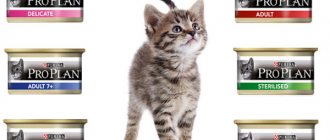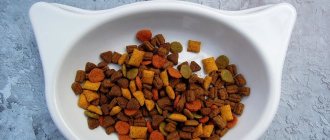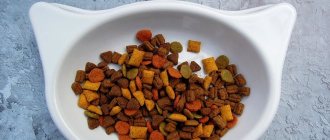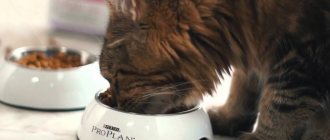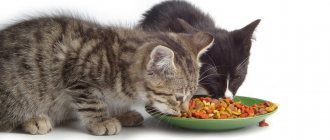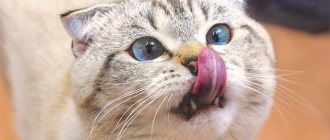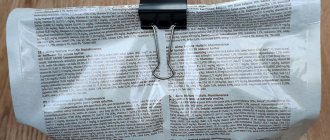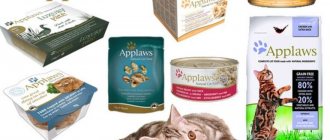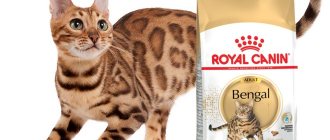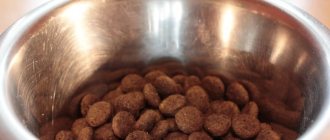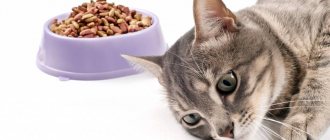Home » Interesting collections about animals
How many times a day should you feed your cat?
For cats of different breeds , as for any other pets, it is extremely important to eat properly, measuredly and nutritiously.
The planned diet must be strictly followed, since timed meals have a beneficial effect on the health, behavior and well-being of the pet.
A well-fed animal behaves more balancedly
The better the animal’s feeding schedule is calculated, the fewer problems arise with its behavior and overall health.
This is explained by the fact that the pet gets used to eating from its own bowl at a certain time, and is not afraid of being hungry.
Therefore, the cat will not beg every time he watches his owner eat.
- 2 How many times a day should you feed your cat?
- 3 How to feed a cat correctly?
The importance of proper nutrition
It happens that owners realize the importance of proper nutrition for their pet only when its health begins to deteriorate. In such cases, it is necessary to urgently change her diet, even if it is a little late.
Especially if this happens during a period of intensive growth and development of the cat’s body. A caring and loving owner should know what and how much to feed a cat as soon as he decides to take it into his home.
A properly selected diet and nutrition regimen, organized for a pet from an early age, ensures the animal a long and healthy existence.
Eating improperly leads to problems in the functioning of many organs and systems. The most common complications occur with the following organs:
- Kidneys;
- Gastrointestinal tract;
- Teeth;
- Joints.
Urolithiasis and allergies may also develop.
Feeding frequency
Proper nutrition includes not only balanced food, but also optimal feeding frequency. The pet’s mood and the health of its body depend on the daily norm. Feeding at regular times reduces the risk of obesity and normalizes digestion.
In addition, with a strict food intake regime, you can assess the cat’s appetite and then make adjustments to the amount of food consumed. In addition, dispensing feed at the scheduled time will prevent food spoilage, especially in hot weather.
How many times a day should you feed your cat?
- At the age of 2 to 3 months - 4-5 times (180-200 g);
- From 4 to 5 months - 3-4 times (240 g);
- From six months - 3 times (240 g);
- Adults - 2 times (200–250 g).
What products are prohibited
The list of permitted foods includes:
- Various types of meat and poultry (beef, veal, lamb, rabbit, chicken, turkey). You can feed the animal with day-old chicks and feed mice sold in pet stores.
- By-products (liver - except pork, chicken hearts or stomachs, kidneys, beef tripe, lungs) contain vitamins and microelements that are not found in plain meat, and therefore are considered an essential part of the diet. They are given in small quantities, otherwise the animal may have problems with stool.
- Fermented milk products (cottage cheese, kefir, yogurt, unsweetened yoghurts without additives). Fat content should be no more than 5%.
- Vegetables (zucchini, lettuce, carrots, pumpkin, greens, broccoli, cauliflower) can be given raw, boiled or steamed. If the animal does not like the taste of vegetables, they are ground into puree and mixed with the meat component.
- Eggs can be given raw or boiled. Only the yolk of chicken eggs is useful to a cat, but quail eggs can be given whole.
- Fish (only sea fish, low-fat varieties, boiled). You can supplement it with seafood - shrimp, cod liver.
Other food supplements (eggs, fish, etc.) are given in small quantities as treats. It is not recommended to feed your cat more than 1-2 times a week.
Prohibited foods for cats:
- onion and garlic;
- whole milk, cheeses, sour cream, fatty dairy products;
- eggplant;
- tomatoes;
- legumes;
- Solanaceae;
- any canned and pickled foods;
- potato;
- fried food;
- food with hot seasonings, spices, salt;
- chocolate;
- sweets;
- flour products;
- mushrooms;
- White cabbage;
- beet;
- hot peppers;
- River fish;
- coffee, alcohol;
- meat and poultry of fatty varieties - pork, duck, lamb.
Ready food
At the moment, there are many different ready-made foods; most owners choose this particular feeding option.
- Since not everyone has time to prepare healthy food from natural products.
- In ready-made food, all ingredients are balanced and provide everything necessary for the pet’s body.
Diet for urolithiasis
For urolithiasis, veterinarians advise using special industrial feeds designed to combat the disease. If it is not possible to purchase high-quality canned food and biscuits, then you can switch to natural products.
Products that contain:
- oxalic acid;
- flavorings and aromas;
- potassium and salt.
Note! With increased amounts of calcium, the pathology can progress. The base should include boiled lean meat
When feeding an animal with KSD, you must adhere to the following requirements:
The base should include boiled lean meat. When feeding an animal with KSD, you must adhere to the following requirements:
- the amount of fermented milk products is reduced by 2 times;
- Chicken and quail eggs are removed from the menu;
- Among vegetables, preference is given to beets, pumpkins, carrots and Brussels sprouts.
Important! Urolithiasis is incompatible with meat broths and offal. The latter contains oxalic acid and purines
Dry food
Ready-made foods produced by different companies have different nutritional properties. Most often, the packaging indicates the weight and age of the pet for which the food is intended, as well as the recommended amount of the product.
Dry food mainly consists of a mixture that includes:
- Meat products;
- Cereals;
- Plant products.
All this is dried using a special method. This food is very convenient because you can safely leave it in a bowl if the cat is left at home alone for a long time. There is no way to visually determine the composition of the granules. Therefore, when choosing a brand of food, you need to know the product category and give preference to premium and super-premium.
How much does a kitten weigh?
Gradual and sufficient weight gain is the main indicator of proper development. If you know the age and breed of the kitten, just weigh it on the scale.
It is advisable to weigh kittens weighing up to 1 kg on electronic kitchen scales that have a small error. To do this, use either a special container that comes with the scales, or a suitable plastic container.
Larger pets can also be weighed on household floor scales. As a last resort, you can weigh yourself, and then with your pet in your arms - and calculate the difference.
It is believed that until the age of six months, a kitten gains, on average, 100 grams of weight per week. After 6 months, the growth of a kitten of most breeds almost stops, but the weight continues to increase due to an increase in muscle mass.
However, there are breed characteristics - for example, Maine Coons grow very slowly and only by two years, or even later, gain their final weight and height. So for more accurate information, it is better to contact the breeder or a specialized website for the breed.
Here is a table showing the approximate weight parameters of kittens of different breeds by month. You can focus on it when determining the norm of development of a kitten.
Kitten weight table
| Development of kittens in the first year of life | ||||||
| Age | Weight of cats, g | Cats weight, g | ||||
| average | big | very large | average | big | very large | |
| 4 weeks | 550 | 630 | 820 | 450 | 560 | 740 |
| 6-8 weeks | 1000 | 1230 | 1500 | 900 | 1150 | 1400 |
| 10-12 weeks | 1350 | 1800 | 2300 | 1200 | 1700 | 2300 |
| 14-16 weeks | 1700 | 2700 | 3800 | 1500 | 2600 | 3600 |
| 5 months | 2050 | 3200 | 5500 | 1800 | 2900 | 4300 |
| 6 months | 2400 | 3900 | 6000 | 2100 | 3200 | 4500 |
| 7 months | 2750 | 4200 | 6500 | 2400 | 3500 | 4900 |
| 8 months | 3100 | 4500 | 6900 | 2700 | 3800 | 5200 |
| 9 months | 3450 | 5000 | 7000 | 3000 | 4100 | 5500 |
| 10 months | 3800 | 5200 | 7700 | 3200 | 4200 | 5800 |
| 11 months | 4050 | 2600 | 8000 | 3350 | 4300 | 6100 |
| 12 months | 4500 | 5700 | 9000 | 3500 | 4500 | 6800 |
| 18 months | 6000 | 9500 | 4700 | 7000 | ||
Wet food
They can be in the form of pouch bags and canned food with pate or stew.
- Pouches are sold in bags of 85 and 100 g.
- The food in them consists of pieces of meat in sauce, with the addition of cereals and plant products.
In addition to vegetables, fish and meat, the products contain added vitamins and minerals. Therefore, this food is a complete nutrition of proper quality.
Daily norm
Conscientious food manufacturers indicate on the packaging information about the recommended daily intake, which depends on the weight and age of the pet.
It is worth noting that if the norm is small, then the product is saturated with nutrients. The average volume of wet food is 5% of the pet’s weight.
Approximately how many times per day to feed an adult cat with ready-made food based on the weight of the animal:
- Up to 3kg - 25g;
- From 3 to 4 kg - 40g;
- From 4 to 5 kg - 55–65 g;
- From 5kg - 12g per 1kg of weight.
Kittens that weigh less than two kilograms per day need 35 grams of food, and those weighing from 2 to 3 kg need 50 grams of food.
For pregnant and lactating cats, the amount of food should be doubled. That is, if a female weighs 4-5 kg, then she will need 100–130 g per day.
When switching your pet to another type of food, you need to gradually mix a new one into the usual food, each time increasing the volume of the new food.
Useful tips
Among other things, you can give some more useful tips on feeding cats:
- If there are several pets in the house that require different diets, feed them separately from each other.
- Be sure to combine wet food with dry food - when chewed, it cleans the teeth of plaque.
- If in the summer heat your cat refuses to eat, but in the fall, on the contrary, eats with excessive appetite, this is normal. Don’t be alarmed, this is how the animal reacts to the changing seasons.
- Cat food should be stored like human food, i.e. observing all sanitary measures.
- Sometimes you can't be too strict. Observe which food your pet enjoys the most, and don’t be shy about pampering him.
- And one more prudent advice: do not start feeding the kitten from your table. To keep those big green eyes by your side for more than twenty years (this is a very realistic period for a pet), do not give him treats from your plate.
Natural diet
It is not easy to create a complete diet from natural products; this requires following some rules and being patient.
- Cats are naturally conservative, so they do not require a varied diet.
- Once you set the correct diet, you can use it constantly.
It is worth considering that to maintain and preserve the health of the animal, free access to water is very important, which needs to be changed twice a day.
Weighing your pet
Kittens will gain weight daily. But to find out the exact weight indicators, it is important to go to the veterinarian and monitor the baby’s growth there.
Typically at 2 weeks, a kitten weighs about 170 grams.
At 2 months, the kitten's weight will reach 900 grams.
At 3 months, the baby, thanks to a proper diet and active lifestyle, will weigh 1400 grams.
By 4 months – 1800 grams.
Closer to six months, when the kitten is completely strong after birth, the weight will be about 2500 grams.
It is necessary to weigh your pet every day, at the same time, so that the indicators are accurate. To weigh your pet, you can use a kitchen scale as the most accurate option.
Weighing a kitten is an essential part of its daily life.
Water in the diet
Water should be present in the bowl at all times, and it should be clean, especially if the pet eats dry food.
- With a natural diet, the cat requires less fluid, but still needs it.
- You can determine whether your pet has enough fluid by looking at its fur and the frequency of urination.
If the coat is silky and shiny, and its owner is active and empties at least twice a day, then this means that the diet contains enough fluid.
Example of an optimal menu
If you are short on time, you can prepare mixtures that are sufficiently nutritious and balanced in advance and freeze them. There are recipes approved by experts, of which the most simple ones can be distinguished.
From meat, buckwheat or rice and vegetables:
- Beef - 2kg;
- Vegetables - 500 g (they are boiled separately).
- Cereals - 200g;
Grind everything in a meat grinder and freeze in portions.
From chicken fillet:
- Chicken fillet - 1 kg;
- Vegetables - 150g.
- Boiled rice - 100g;
Pass everything through a meat grinder, form into balls and boil. After the meatballs have cooled, they need to be frozen.
In addition to main dishes, a cat’s daily diet should include about 30 grams of fermented milk products.
The choice of type of feeding for a pet depends on the owner, his capabilities and preferences. Each food has its own advantages and disadvantages. A caring owner will, if desired, find the best option for his pet.
